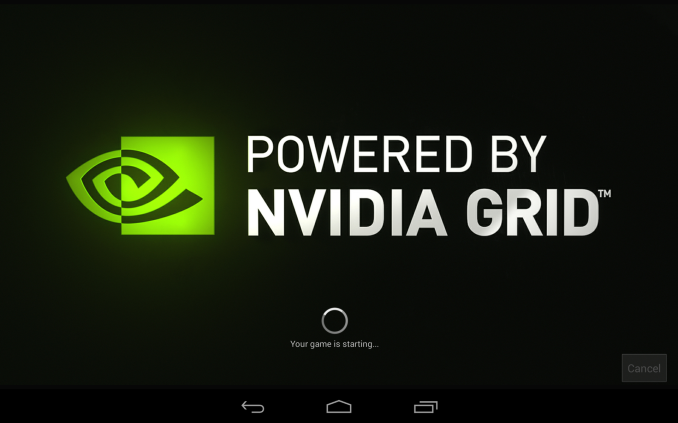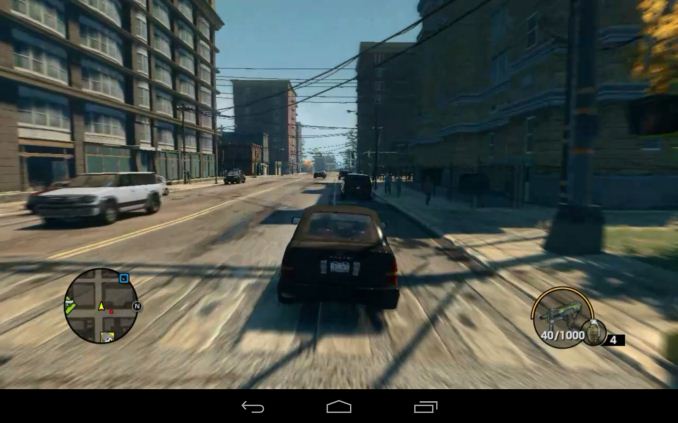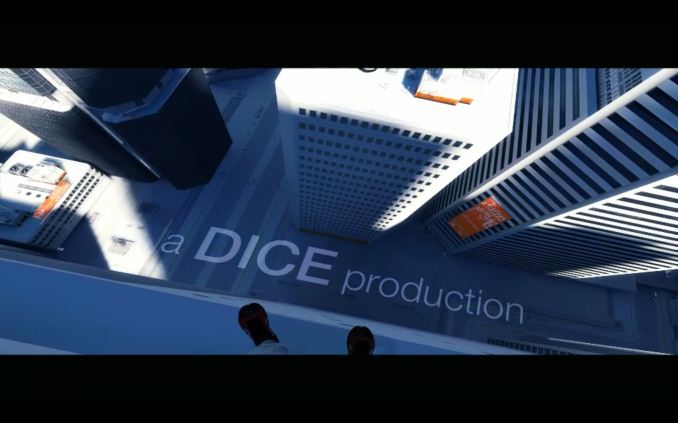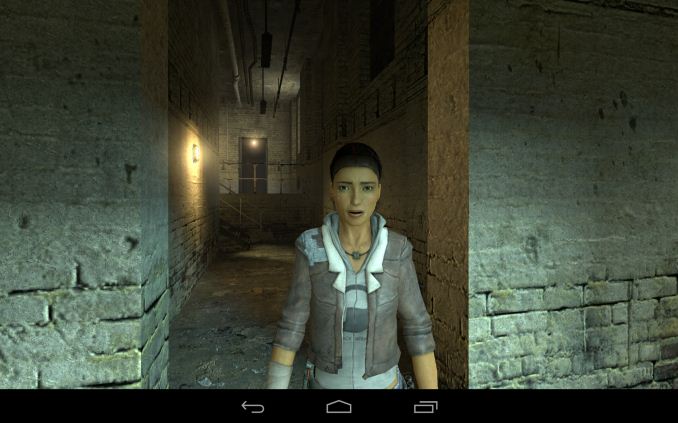The NVIDIA SHIELD Tablet Review
by Joshua Ho on July 29, 2014 9:00 AM ESTGameStream and GRID
The final software features that Shield Tablet brings to the table are GameStream and GRID. These are effectively methods of turning the tablet into a thin client, as all of the rendering/computation is done on a computer either in the LAN or on a server in San Jose. From a technical perspective, both work great as long as the connection has high bandwidth and low latency. For GRID, I managed to get a great user experience on a symmetrical 10 Mbps connection and around 10ms latency to the server. Games like Saints Row 3 played as if running on a console when the device is actually streaming from NVIDIA servers. From the user’s perspective, it’s a matter of going into the app drawer, opening GRID, and selecting a game. It’s simple and given sufficient server coverage I could easily see a Netflix-style usage model taking off quite successfully.
Although I didn’t spend as much time with GameStream, I didn’t detect any input lag and for the most part it’s just as simple. As long as a GameStream-enabled PC is on the same network, accessing GameStream compatible games is just a matter of going to the Shield Hub application, entering a four digit code on the PC to pair it with the tablet, and selecting a game. GameStream also works remotely, but the same caveats that come with GRID apply to GameStream on both the server and client end. Of course, the games that will run on GameStream have to be carefully selected. While it’s fully possible to play a twitch shooter like Call of Duty through GameStream, trying to use a controller in multiplayer is simply a massive disadvantage against people that are competent with a mouse and keyboard. I've included a screenshot of Mirror's Edge that I took while testing GameStream.
Gaming Ecosystem
Ultimately, I’m a bit conflicted on whether GameStream and GRID are really designed to stand on their own though. GameStream only works while you’re at home, and GRID is highly dependent upon low latency and also needs around 10 Mbps download and 5 Mbps upload for an ideal experience. Due to the latency requirement and the fact that the only GRID server bank is in San Jose, the very low latencies that GRID is best suited for are generally only achievable in California and parts of other nearby states. They’re definitely great in the situations that they work, but ultimately the native game library has to stand alone. To this end, the tablet is in a far better situation than the original Shield. The number of games that provide a quality gaming experience is now leaps and bounds better than what we saw with the launch of the Shield Portable. Trine 2 is included out of the box, and while I didn’t get a chance to try co-op mode it’s a compelling experience that once needed GameStream or GRID to be played on Shield. Along the same lines, the Grand Theft Auto series, Half Life 2, and Portal all play surprisingly well.
Fundamentally though, I don’t think single player games alone will sell Shield as a gaming platform. A single player game can only have a certain amount of replay value. Something like Half Life 2 might have 12 hours of gameplay at best. In comparison, multiplayer has massive amounts of replay value because even the same map can play out differently depending upon the people that play in the round. It’s that factor that makes it possible for people to spend 1200 hours playing a game like Battlefield 2. Unfortunately, for the most part the Shield tablet has a game library that seems to be skewed towards single player games. Fortunately, NVIDIA seems to understand this. While I haven’t been able to play War Thunder on Shield tablet, the promise of compelling multiplayer games on this device would be a strong enough reason to excuse potential shortcomings in other areas. Although it's good that an immersive multiplayer title is coming to Shield tablet, the key point of emphasis is that people playing a Shield device can play with those on console or PC as well. Until NVIDIA hits critical mass for Shield device adoption, multiplayer titles that only allow people on Shield to play with others on Shield will struggle because people won't play multiplayer unless there are other people to play with.















174 Comments
View All Comments
ddriver - Tuesday, July 29, 2014 - link
What you mean by "rich colors" is OVER-SATURATION, not color accuracy but the full opposite of it. Most games actually prefer TN panels because of their fast refresh rates, and TN panels' color accuracy suks big time.aliquis - Sunday, November 9, 2014 - link
Regardless it's fair to say most gamers use TN monitors and those are far from perfect but gamers have used them anyway due to speed or price.B3an - Tuesday, July 29, 2014 - link
I know for a fact i can see a noticeable difference. In the same way i can easily see a difference between IPS and shitty TN panels. So YOU'RE fooling yourself if you actually believe that.inighthawki - Tuesday, July 29, 2014 - link
And you're showing your foolishness by comparing color accuracy to color precision. The difference between TN and IPS panels typically stems from color depth. Most TN panels are 6 bit color with dithering, while IPS panels can be 8 bit, or 10 bit simulated, producing a higher range of visible color.Here we are talking about the ACCURACY of colors. i.e. that shade of blue appears as (10, 24, 237) instead of (11, 28, 233). While playing a game, this kind of thing is generally unnoticeable, because you do not have a reference image or render to define what it should look like in the first place. In rare cases when you have large swatches of deep vivid colors you might notice they are a bit undersaturated, but for the most part, the lighting and texture quality in even AAA titles do not produce this kind of photorealism.
ddriver - Tuesday, July 29, 2014 - link
And in the end, it is all relative, since all humans perceive colors differently. This is not an issue for calibrating equipment, which itself can be calibrated, but the human eye is an analogue instrument and no calibration for its color reproduction currently exists.Color accuracy is vital only in one field - and that is content creation. I paid 7k for a "reference" screen and 4k for reference audio monitors, and exactly for that reason. But for content consumption it is irrelevant, considering most users don't even have pro-grade equipment and the content is going to be consumer on a wide range of devices, ranging from totally cr@ppy to above decent.
niva - Tuesday, July 29, 2014 - link
Seriously, the color accuracy being 1% or even 10% off will really mess up your gaming experience? Color accuracy is wildly irrelevant to anyone but professionals who work in image/print/video production industries.dstarr3 - Tuesday, July 29, 2014 - link
I have to agree that color accuracy in gaming is a non-issue. In developing games, sure. But not in playing them. It's not like anyone is printing screenshots for work. Unless, again, you're a dev.ddriver - Tuesday, July 29, 2014 - link
Nah, I am not a moron, in fact I've been an artist in a AAA game studio for 6 years, so I know what I am talking about. You on the other hand might just be that, seeing your "foolproof" argumentation skills :Dmikegonzalez2k - Wednesday, August 6, 2014 - link
Most of these people probably aren't in the industry and hence wouldn't know such things. That is why they are consistently on here instead of working on actual projects. Especially those that comment daily. You have to wonder what they are doing with their life. I wouldn't pay them much attention. It isn't worth it.dcyli - Wednesday, July 30, 2014 - link
HURR DURR, I PLAY GAMES FOR DA COLORS. DUURRR